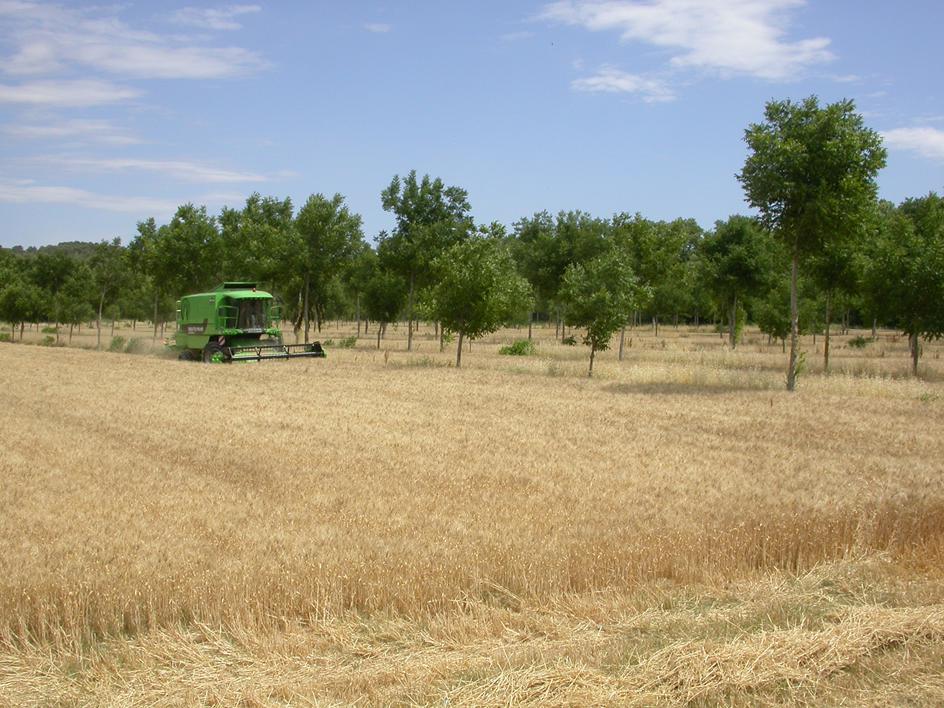
Mediterranes silvoarables System in Frankreich
Beschreibung des Systems
Die hohe saisonale Schwankung von Niederschlag in den mediterranen Regionen von Südfrankreich begrenzt kultivierbare Erträge. Es gibt Perioden im Herbst, wo der Niederschlag sehr hoch ist und wiederum Wasserknappheit im Frühling und Sommer. Durch diese Situation entstanden in manchen Regionen mit tiefer Erde, welche fähig sind das Wasser zu speichern, silvoarable Agroforstsysteme (Felder mit Baumsäumen). Diese Systeme verbessern das Fremdwasser, hindern Erdverdunstung und beschränken Anforderungen an Wasser für Getreide.
Das erste Stakeholder Treffen
Das erste Treffen der Interessensgruppe wurde am 2. Oktober 2014 gehalten und beinhaltete Besuche zur INRA Mauguio Experimenten Landschaft und den silvoarablen Systemen in Restinclière. Die Forschung in Mauguio beinhaltete eine grosse Selektion von Getreide. Die Bauern, die teilnahmen haben die Einkommensunterschiede, Getreideproduktion, Verbesserung der Biodiversität, Lebensraum der Wildtiere und Erhaltung des Bodens als positive Aspekte des silvoarablen Agroforstsystems genannt. Die negativen Themen beinhalten die betriebswirtschaftlichen Chancen, Cash Flow, Getreideverluste von Schnecken und Hirsche und Wildschweine. Eine potentielle Forschungsidee wäre eine Selektion von Hartweizen, welche geeignet wäre für die Agroforstkonditionen.
Falls Sie mehr über die Aktivitäten dieser Gruppe wissen möchten, kontaktieren Sie bitte Dr. Marie Gosme (marie.gosme@supagro.inra.fr) von INRA.
Laden Sie den ersten Bericht der Interessensgruppe runter
Ein erster Berich wurde im Oktober 2014 veröffentlicht.
Laden Sie den ersten Forschungs- und Entwicklungsbericht runter
Diese Interessengruppe veröffentlichte zwei Protokolle: Das erste Protokoll fokussiert sich auf die Selektion der Hartweizen für Agroforstsysteme und das Zweite dreht sich um Grasmanagement in silvoarablen Systemen.
Laden Sie die Systembeschreibung runter
Zwei Systembeschreibungen, welche eine aktualisierte Selektion des Hartweizens und Grasmanagement liefern, wurden im Januar 2016 veröffentlicht.
Lessons learnt
In the first report, Marie Gosme and Dominique Desclaux describe the lessons learnt from screening durum wheat cultivars for their suitability in agroforestry systems in Mediterranean France. Up to 45 cultivars were compared in control and agroforestry conditions in up to three sites for up to three seasons. Crops under agroforestry conditions received between 40 and 75% of the light available in unshaded areas. Mean yields were low in 2015, were about 1.9 t/ha in 2016 and 2.7 t/ha in 2017. The cultivars showed large variability in their suitability for agroforestry conditions with yield differences in agroforestry compared to full sun conditions ranging from -62% to +77 %. Old varieties and varieties based on populations were not systematically more adapted to agroforestry than newer or pure-line cultivars.
In the second report, Delphine Mézière and colleagues at INRA in Southern France measured the effect of the tree-rows within silvoarable systems on the species and abundance of weeds, relative to open field conditions, over 2015 and 2016. Herbicide use was limited to a single post-winter spray. In the barley crop in 2015, on average about seven weed species/m² were found in the arable section of the agroforestry plot, compared to six species/m² in the open arable field. The number of weed individuals was lower in the agroforestry arable crop (about 50/m2) than in the open field (about 75/m2). With a pea crop in 2016 there was some evidence that the weed abundance in the crop was higher in the crop margin (next to the tree row) than in the centre of the arable alley.